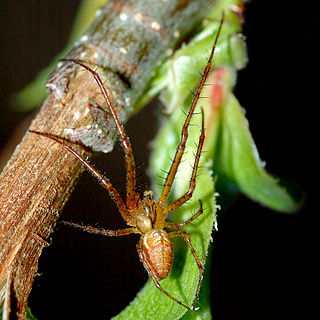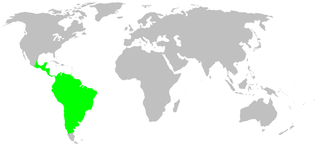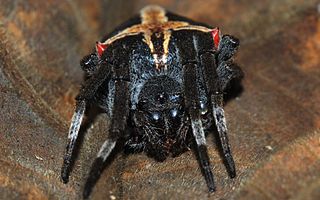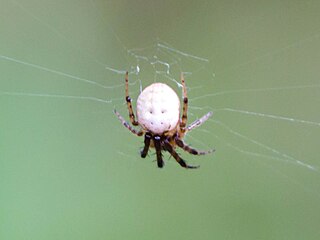
Long-jawed orb weavers or long jawed spiders (Tetragnathidae) are a family of araneomorph spiders first described by Anton Menge in 1866. They have elongated bodies, legs, and chelicerae, and build small orb webs with an open hub with few, wide-set radii and spirals with no signal line or retreat. Some species are often found in long vegetation near water.

Argyrodes, also called dewdrop spiders, is a genus of comb-footed spiders that was first described by Eugène Louis Simon in 1864. They occur worldwide, and are best known for their kleptoparasitism. They can spin their own webs, but tend to invade and reside in their hosts' webs. This relationship can be commensal or even mutual if the dewdrop spider feeds on small trapped insects that are not eaten by the host. Some species can even prey upon the host.

Micrathena, known as spiny orbweavers, is a genus of orb-weaver spiders first described by Carl Jakob Sundevall in 1833. Micrathena contains more than a hundred species, most of them Neotropical woodland-dwelling species. The name is derived from the Greek "micro", meaning "small", and the goddess Athena.

Dolichognatha is a genus of tropical and subtropical long-jawed orb-weavers that was first described by Octavius Pickard-Cambridge in 1869. Originally placed with the Archaeidae, it was transferred to the Araneidae in 1967, and to the Tetragnathidae in 1981.

Coneweb spiders (Diguetidae) are six-eyed haplogyne spiders that live in tangled space webs, fashioning a cone-like central retreat where they hide and lay eggs. It is a small family, containing only two genera split between a range in the Southwestern United States and Mexico and a range in South America. Members of the genus Diguetia usually build their webs in shrubs or between cactus pads. They have the same eye arrangement as the venomous recluse spiders, but none are known to be harmful to humans.

Senoculus is a genus of araneomorph spiders in the family Senoculidae, and was first described by Władysław Taczanowski in 1872. It is the only genus in the family Senoculidae.

Metepeira is a genus of orb-weaver spiders first described by F. O. Pickard-Cambridge in 1903. The name is derived from the Ancient Greek μετά and the obsolete genus name Epeira, denoting a genus similar to Epeira.

Glenognatha is a genus of long-jawed orb-weavers that was first described by Eugène Louis Simon in 1887. It was considerably revised in 2016.

Parawixia is a genus of orb-weaver spiders first described by F. O. Pickard-Cambridge in 1904. Most species are found in the Neotropics but one species, Parawixia dehaani, is found in Australasia and tropical Asia as far west as India.

Corinna is a genus of corinnid sac spiders first described by Carl Ludwig Koch in 1841. They are found in Mexico and south to Brazil, and with selected species found in Africa.

Ochyrocera is a genus of midget ground weavers that was first described by Eugène Louis Simon in 1892.

Trachelas is a genus of araneomorph spiders originally placed with the Trachelidae, and later moved to the Corinnidae.
Chrysometa is a genus of long-jawed orb-weavers that was first described by Eugène Louis Simon in 1894. It is a senior synonym of Capichameta.
Cyrtognatha is a genus of long-jawed orb-weavers that was first described by Eugen von Keyserling in 1881. It is a senior synonym of Agriognatha. Species of this genus are found in The Americas.
Mollemeta is a monotypic genus of long-jawed orb-weavers endemic to Chile. It contains the single species, Mollemeta edwardsi, first described as Landana edwardsi, based on a female found in 1904. The name is a reference to "Molle", the Mapudungun word for "tree", because it builds its vertical orb webs on tree trunks. It is in a clade with Allende, Chrysometa, Dolichognatha, Meta, and Metellina due to several autapomorphies, including the unique shapes of the cymbium, conductor, and embolus.

Eustala is a genus of orb-weaver spiders first described by Eugène Simon in 1895.

Metazygia is a genus of orb-weaver spiders first described by F. O. Pickard-Cambridge in 1904. They physically resemble members of Nuctenea, but they do not have fine setae on the carapace.

Neospintharus is a genus of comb-footed spiders that was first described by H. Exline in 1950. It was synonymized with Argyrodes in 1962, but revalidated in 2004.
Allende is a genus of South American long-jawed orb-weavers that was first described by F. Álvarez-Padilla in 2007.














